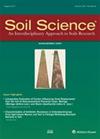Reproducibility of the wet part of the soil water retention curve: a European interlaboratory comparison
4区 农林科学
Q2 Agricultural and Biological Sciences
引用次数: 0
Abstract
Abstract. The soil water retention curve (SWRC) is a key soil property required for predicting basic hydrological processes. The SWRC is often obtained in the laboratory with non-harmonized methods. Moreover, procedures associated with each method are not standardized. This can induce a lack of reproducibility between laboratories using different methods and procedures or using the same methods with different procedures. The goal of this study was to estimate the inter- and intralaboratory variability of the measurement of the wet part (from 10 to 300 hPa) of the SWRC. An interlaboratory comparison was carried out between 14 laboratories, using artificially constructed, porous reference samples that were transferred between laboratories according to a statistical design. The retention measurements were modelled by a series of linear mixed models using a Bayesian approach. This allowed the detection of sample-to-sample variability, interlaboratory variability, intralaboratory variability and the effects of sample changes between measurements. The greatest portion of the differences in the measurement of SWRCs was due to interlaboratory variability. The intralaboratory variability was highly variable depending on the laboratory. Some laboratories successfully reproduced the same SWRC on the same sample, while others did not. The mean intralaboratory variability over all laboratories was smaller than the mean interlaboratory variability. A possible explanation for these results is that all laboratories used slightly different methods and procedures. We believe that this result may be of great importance regarding the quality of SWRC databases built by pooling SWRCs obtained in different laboratories. The quality of pedotransfer functions or maps that might be derived is probably hampered by this inter- and intralaboratory variability. The way forward is that measurement procedures of the SWRC need to be harmonized and standardized.土壤保水曲线湿润部分的再现性:欧洲实验室间比较
摘要土壤保水曲线(SWRC)是预测基本水文过程所需的关键土壤性质。SWRC通常是在实验室用非统一的方法获得的。此外,与每种方法相关的程序没有标准化。这可能导致使用不同方法和程序的实验室之间缺乏可重复性,或使用不同程序的相同方法。本研究的目的是估计SWRC湿部分(从10到300 hPa)测量的实验室间和实验室内的变异性。在14个实验室之间进行了实验室间比较,使用人工构建的多孔参考样品,根据统计设计在实验室之间转移。利用贝叶斯方法,用一系列线性混合模型对滞留量测量进行建模。这允许检测样品到样品的可变性,实验室间的可变性,实验室内的可变性和测量之间样品变化的影响。SWRCs测量差异的最大部分是由于实验室间的变异性。实验室内的变异性根据实验室的不同而变化很大。一些实验室成功地在同一样品上复制了相同的SWRC,而另一些则没有。所有实验室的平均实验室内变异性小于平均实验室间变异性。对这些结果的一种可能解释是,所有实验室使用的方法和程序略有不同。我们认为,这一结果可能对通过汇集不同实验室获得的SWRC而建立的SWRC数据库的质量具有重要意义。可能得到的土壤传递函数或地图的质量可能受到这种实验室间和实验室内部变异性的影响。今后的方向是协调和标准化SWRC的测量程序。
本文章由计算机程序翻译,如有差异,请以英文原文为准。
求助全文
约1分钟内获得全文
求助全文
来源期刊

Soil Science
农林科学-土壤科学
CiteScore
2.70
自引率
0.00%
发文量
0
审稿时长
4.4 months
期刊介绍:
Cessation.Soil Science satisfies the professional needs of all scientists and laboratory personnel involved in soil and plant research by publishing primary research reports and critical reviews of basic and applied soil science, especially as it relates to soil and plant studies and general environmental soil science.
Each month, Soil Science presents authoritative research articles from an impressive array of discipline: soil chemistry and biochemistry, physics, fertility and nutrition, soil genesis and morphology, soil microbiology and mineralogy. Of immediate relevance to soil scientists-both industrial and academic-this unique publication also has long-range value for agronomists and environmental scientists.
 求助内容:
求助内容: 应助结果提醒方式:
应助结果提醒方式:


